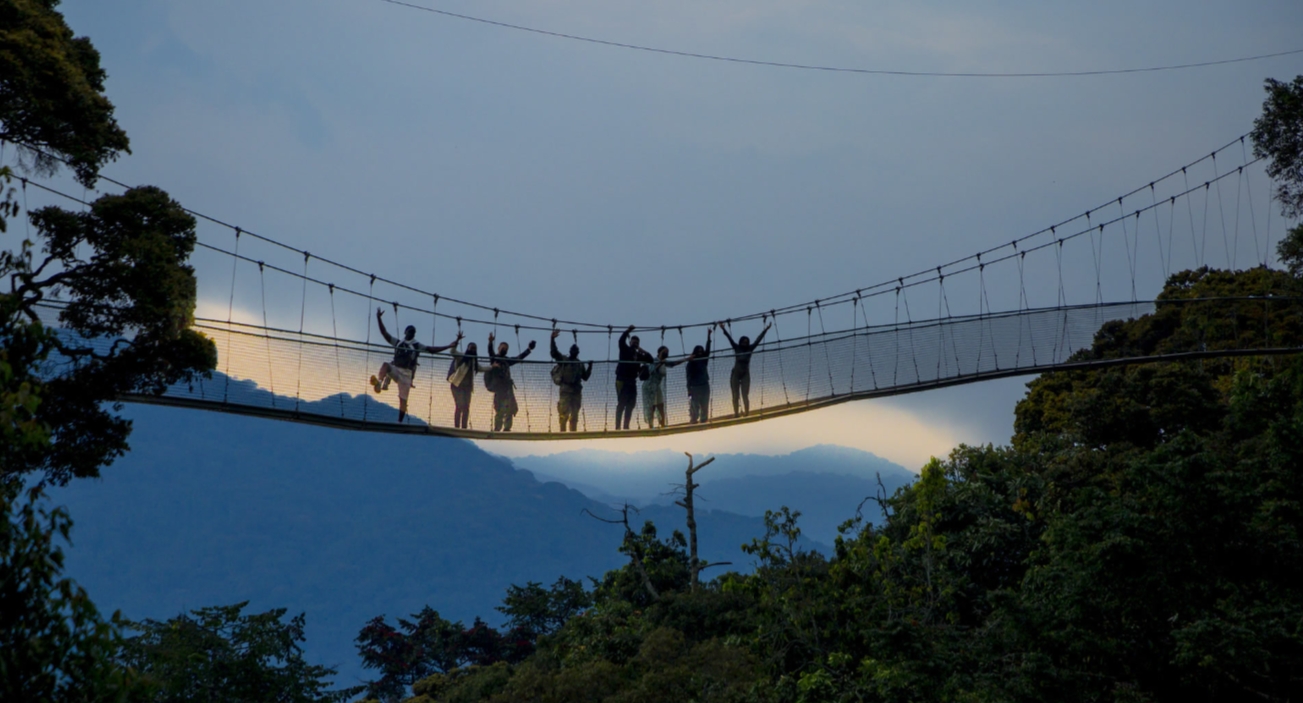
Exploring Nyungwe Forest National Park
Exploring Nyungwe National Park: This is one of the renowned destinations famous for primate concentrations, especially the intelligent chimpanzees and other unique primates, among others. This unique forest is located next to Lake Kivu in the west and closer to the Burundian border. The forest is one of the vibrant and unique forests with a rich biodiversity in the Albertine Rift, and a top ancient montane forest in Africa, located between the Congo River to the west and the Nile River basin to the east. The forest’s catchment area is the area between the two rivers. Numerous bird species and a diverse population of primates, including chimpanzees, may be found in the park, which is well known for its great biodiversity.
This leafy rainforest was created in 2004 as part of the country’s conservation efforts to preserve its distinctive wildlife, including primates and bird species. Over 1,019 km² of tropical rain forest, bogs, bamboo, wetlands, and grassland make up the forest. Rwanda’s initiatives through the Rwanda Development Board and African Parks, an independent body responsible for managing and protecting the country’s wildlife. Later, in 2023, Nyungwe Forest was designated a UNESCO World Heritage Site and added to the list.
The wide variety of wildlife seen in Nyungwe Forest National Park makes it an outstanding example of African wildlife conservation. At the intersection of various large-scale biogeographical transition zones, this dense forest is ideally situated. A variety of terrestrial, or earthly, biomes provide a wide diversity of microhabitats for numerous plant and animal species.
Nyungwe Forest National Park plays a significant role in the country’s ecosystem, particularly in the Albertine Rift, with several primate species totalling 13 species, 85 mammals, 38 reptiles, 300 bird species, 32 amphibians, and others. This Afromontane forest region houses unique primate species with restricted distribution, such as the presence of chimpanzee troops and several other primates.
Primate species
The park has several unique primates that are rarely found anywhere else; these include the common chimpanzee (Pan troglodytes), olive baboon (Papio anubis), Hamlyn’s monkey (Cercopithecus kandti), Ruwenzori colobus (Colobus angolensis ruwenzori), olive baboon (Papio anubis), vervet monkey (Chlorocebus pygerythrus), grey-cheeked mangabey (Cercopithecus ascanius), Hamlyn’s monkey (Cercopithecus hamlyni), Dent’s mona monkey (Cercopithecus denti), L’Hoest’s monkey (Cercopithecus l’hoesti), golden monkey (Cercopithecus kandti), grey-tailed monkey (Cercopithecus l’hoesti), and vervet monkey (Chlorocebus pygerythrus), among others.
During the 1920s, the colonial authorities had been concerned about the rising shifts from forest to pastureland. The country’s laws governing its forest reserves interdicted clearing forest land for agriculture but empowered the community with rights to get firewood with valuable exploitation of hardwood timber for commercial purposes.
Later, in 1933, the Belgian colonial government gazetted Nyungwe Forest Reserve as a forest reserve, enhancing the park’s function in preserving the ecosystem and fauna of the nation and the region.
Rwanda’s Ministry of Agriculture was in charge of managing its forest reserves after gaining independence in 1962. However, because of the fire outbreaks and human activities such as farming, hunting, and others, the park was reduced to over 150 km² between 1958 and 1973. This had to cut across even in other parks such as Volcanoes National Park and the newly promoted Gishwati Mukura, among others. Other wildlife species to see include buffalo, elephants, and primates such as red-tailed monkeys, mangabeys, chimps, L’Hoest’s monkeys, and others.
To enforce sustainability and timber output, Nyungwe Forest was divided into sections in 1984. Still, the Rwandan government devised a neutral zone plan, and the Wildlife Conservation Society (WCS) monitored wildlife, recording more than 400 colobus individuals, which at the time was noteworthy.
In 1987, Uwinka, located within Nyungwe National Park, registered progress in the trail system, but due to the civil unrest of 1994, Rwanda’s genocide devastated the country, where most of the senior personnel officers fled the country, leaving the park in the hands of the junior officers, contributing to a slight decline and extinction of some animals. Even though Nyungwe Forest started to recover following the Rwandan genocide in 1994, security and stability remained dubious because the majority of the big game species, including buffalo and elephants, were scarce.
Economic Implication-Exploring Nyungwe Forest National Park
Nyungwe National Park plays a significant part in Rwanda’s economy, contributing about $4.8 billion a year. The autonomous body responsible for managing, monitoring, and protecting Nyungwe Forest National Park and its goals aims at increasing revenue and also fostering sustainable tourism, among others. This has immensely contributed to the country’s revenue, which has significantly transformed the country’s infrastructural development.
Conclusion
In recognition of its abundant biodiversity, which includes rare primates such as the famous chimpanzees and other wildlife species, Nyungwe Forest National Park is one of the most popular tourist destinations in Rwanda, a country of a thousand hills. As such, it is prioritized to support Rwanda’s economy, sustainable tourism, and African conservation.
